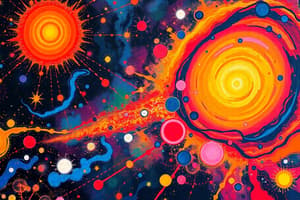Podcast
Questions and Answers
Which elements were produced in the first few minutes of the Big Bang?
Which elements were produced in the first few minutes of the Big Bang?
- Oxygen, carbon, and nitrogen
- Hydrogen, helium, and lithium (correct)
- Gold, silver, and platinum
- Nitrogen, oxygen, and neon
According to the BBFH theory, where were all the elements in the Universe thought to have been produced?
According to the BBFH theory, where were all the elements in the Universe thought to have been produced?
- In the interstellar medium
- Stellar interiors or during supernova explosions (correct)
- During planetary collisions
- Within black holes
What enigma exists for helium and deuterium according to the text?
What enigma exists for helium and deuterium according to the text?
- Their production is dependent on planetary collisions
- They can only be produced in black holes
- Their production in stellar interiors exceeds theoretical predictions (correct)
- They are not found in the Universe
What was the major shortcoming of the predominant theory regarding the formation of chemical elements in the Universe according to the text?
What was the major shortcoming of the predominant theory regarding the formation of chemical elements in the Universe according to the text?
Which elements are thought to have their origins in the interiors of stars which formed much later in the history of the Universe?
Which elements are thought to have their origins in the interiors of stars which formed much later in the history of the Universe?
What theory provides a satisfactory explanation for the production of light elements in the early Universe?
What theory provides a satisfactory explanation for the production of light elements in the early Universe?
At what temperature did nucleosynthesis, or the production of light elements, take place in the early Universe?
At what temperature did nucleosynthesis, or the production of light elements, take place in the early Universe?
What is the predicted mass percentage of Helium in the Universe according to the Big Bang Nucleosynthesis theory?
What is the predicted mass percentage of Helium in the Universe according to the Big Bang Nucleosynthesis theory?
What is an important piece of evidence supporting the Hot Big Bang model?
What is an important piece of evidence supporting the Hot Big Bang model?
Why must we consider more exotic particle candidates for dark matter?
Why must we consider more exotic particle candidates for dark matter?
Flashcards are hidden until you start studying
Study Notes
Big Bang Nucleosynthesis
- Light elements like hydrogen, helium, and traces of lithium and beryllium were produced during the first few minutes post-Big Bang.
- According to the BBFH (Big Bang Nucleosynthesis) theory, all elements were thought to be produced exclusively in the hot, dense conditions of the early Universe.
Helium and Deuterium Enigma
- An enigma exists regarding helium and deuterium, as observed cosmic abundances do not align with theoretical predictions, suggesting complex processes influencing their formation and distribution.
Shortcomings of Previous Theories
- The predominant theory of element formation faced criticism for not adequately explaining the observed ratios and abundances of light elements compared to predictions.
Stellar Origins of Elements
- Heavier elements like carbon, oxygen, and iron are thought to originate from stellar interiors, formed through nuclear fusion in stars that developed later in the Universe’s timeline.
Satisfactory Explanations for Early Element Production
- The Hot Big Bang theory provides a coherent explanation for the production of light elements during the early Universe phase.
Conditions for Nucleosynthesis
- Nucleosynthesis occurred at extremely high temperatures, approximately 10 billion Kelvin, allowing for the fusion of protons and neutrons.
Predicted Helium Mass Percentage
- The Big Bang Nucleosynthesis theory predicts that helium comprises around 25% of the total mass of ordinary matter in the Universe.
Evidence for the Hot Big Bang Model
- Cosmic Microwave Background Radiation (CMB) serves as a fundamental piece of evidence supporting the Hot Big Bang model, showcasing uniform temperature and density across the Universe.
Exotic Particle Candidates for Dark Matter
- Consideration for more exotic particle candidates for dark matter is necessary due to the limitations of conventional matter in explaining gravitational effects observed on cosmic scales.
Studying That Suits You
Use AI to generate personalized quizzes and flashcards to suit your learning preferences.




